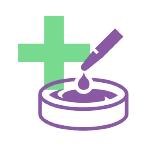What does HER2 do in aBC?
HER2 is a receptor on the outside of cancer cells that helps them grow and divide.7 When breast cancer cells have a lot of HER2-positive (HER2+) receptors, they may grow more quickly and be more likely to spread to other parts of the body.7
What do PIK3CA mutations do in aBC?
Each of your genes contains a set of instructions that tells a cell how to build a different part of itself.5,8 Some gene mutations (errors) cause cells to grow in unhealthy ways, as happens in cancer.1,9
The PIK3CA gene instructs part of the cell called phosphatidylinositol-3-kinase α (PI3Kα).5,8 When PIK3CA has a mutation, it gives the wrong instructions for PI3Kα causing PI3Kα to become ‘activated’.5,8
Activated PI3Kα tells the cell to grow and divide more than normal, which can:5,8
- Cause the tumour to grow
- Make certain treatments less effective
- Lead to a worse outcome for patients with aBC














